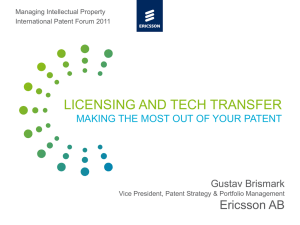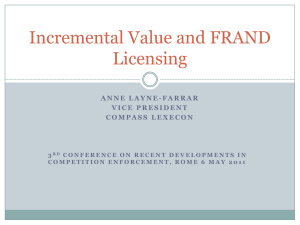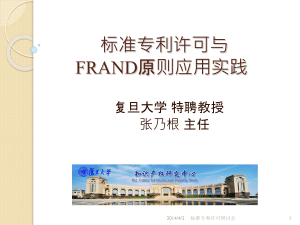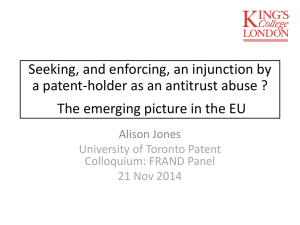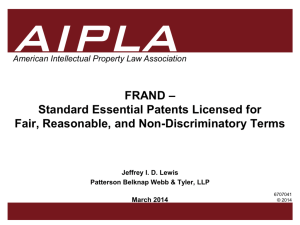patent roundtable
advertisement
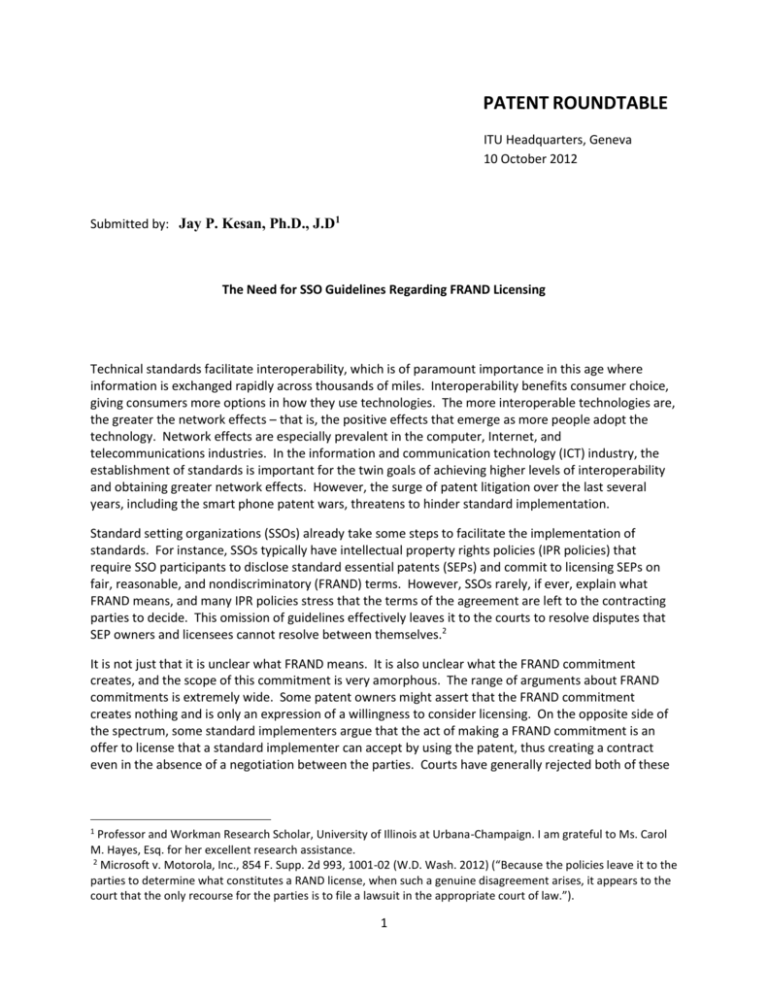
PATENT ROUNDTABLE ITU Headquarters, Geneva 10 October 2012 Submitted by: Jay P. Kesan, Ph.D., J.D1 The Need for SSO Guidelines Regarding FRAND Licensing Technical standards facilitate interoperability, which is of paramount importance in this age where information is exchanged rapidly across thousands of miles. Interoperability benefits consumer choice, giving consumers more options in how they use technologies. The more interoperable technologies are, the greater the network effects – that is, the positive effects that emerge as more people adopt the technology. Network effects are especially prevalent in the computer, Internet, and telecommunications industries. In the information and communication technology (ICT) industry, the establishment of standards is important for the twin goals of achieving higher levels of interoperability and obtaining greater network effects. However, the surge of patent litigation over the last several years, including the smart phone patent wars, threatens to hinder standard implementation. Standard setting organizations (SSOs) already take some steps to facilitate the implementation of standards. For instance, SSOs typically have intellectual property rights policies (IPR policies) that require SSO participants to disclose standard essential patents (SEPs) and commit to licensing SEPs on fair, reasonable, and nondiscriminatory (FRAND) terms. However, SSOs rarely, if ever, explain what FRAND means, and many IPR policies stress that the terms of the agreement are left to the contracting parties to decide. This omission of guidelines effectively leaves it to the courts to resolve disputes that SEP owners and licensees cannot resolve between themselves.2 It is not just that it is unclear what FRAND means. It is also unclear what the FRAND commitment creates, and the scope of this commitment is very amorphous. The range of arguments about FRAND commitments is extremely wide. Some patent owners might assert that the FRAND commitment creates nothing and is only an expression of a willingness to consider licensing. On the opposite side of the spectrum, some standard implementers argue that the act of making a FRAND commitment is an offer to license that a standard implementer can accept by using the patent, thus creating a contract even in the absence of a negotiation between the parties. Courts have generally rejected both of these 1 Professor and Workman Research Scholar, University of Illinois at Urbana-Champaign. I am grateful to Ms. Carol M. Hayes, Esq. for her excellent research assistance. 2 Microsoft v. Motorola, Inc., 854 F. Supp. 2d 993, 1001-02 (W.D. Wash. 2012) (“Because the policies leave it to the parties to determine what constitutes a RAND license, when such a genuine disagreement arises, it appears to the court that the only recourse for the parties is to file a lawsuit in the appropriate court of law.”). 1 extremes, with several courts concluding that a FRAND commitment creates a duty for the patent owner to negotiate in good faith.3 Currently, the courts are entrusted with clarifying issues relating to FRAND commitments, but this approach is very inefficient. First, litigation is expensive for all parties involved. Second, courts do not have a very effective method of determining a reasonable royalty either. In the United States, the most commonly cited set of guidelines is a lengthy and unwieldy fifteen factor test set forth in Georgia Pacific Corp. v. U.S. Plywood Corp.,4 which is widely maligned by practitioners and academics due to the difficulty of applying the test reliably. FRAND conflicts also are currently likely to be resolved through fact-intensive inquiries that make it difficult to apply lessons between disputes. Between the high costs of civil litigation and the fifteen (or more) factors that may be relevant to determining a reasonable royalty, there is a clear need for a better solution than ad hoc adjudication. A better solution would benefit the parties to a dispute, but it would also have significant benefit to the consumers who purchase goods relying on the interoperability benefits and network effects facilitated by standards. If we accept that the current lack of clarity in FRAND commitments is a problem, the next step is to determine whether there is an alternative that would be more effective and efficient than civil litigation. We suggest that SSOs are in a unique position to set out guidelines ex ante to mitigate conflicts between patent owners and standard implementers. There are a number of approaches that SSOs could take to reduce the burden of resolving FRAND disputes. For instance, some commentary has discussed the possibility that SSOs could provide for certain dispute resolution processes by, for example, providing an alternate dispute resolution option through the SSO itself. An ADR option would likely provide benefits over civil litigation due to the SSO’s expertise in both the technology and the nature of the field, but it would also impose many burdens on the SSO. Additionally, an ADR option would still emphasize ex post resolution of disputes, albeit in a context where the disputes are potentially more easily understood. Arbitration is another potential alternative for ex post resolution, but while it is less costly than litigation, resolution will be difficult without guidelines. The approach that we think would be most beneficial for mitigating conflicts is for SSOs to establish guidelines governing FRAND commitments. These guidelines, however, need not be concrete to the point of setting forth acceptable ranges for royalties. A single standard could potentially implicate dozens of patents, and a single product could potentially implement dozens of standards. It would be unreasonable to expect an SSO to take all of these different factors into account and weigh the value of each patent before a standard is in wide use. It would, however, be both feasible and desirable for SSOs to establish guidelines applying high level principles to several commonly contentious issues. For starters, SSOs should include rules governing disclosure, essentiality, transferability, and remedies. This list is not exhaustive, but we think that it can provide a starting point for establishing guidelines ex ante. Many of these topics are already addressed by IPR policies, but further clarification could be beneficial for resolving disputes. First, IPR policies often require participants to disclose relevant technologies to the SSO, but the policy should be explicit on two points: (1) what must be disclosed, and (2) what default rule applies in the case of nondisclosure. As to the first point, the SSO should clarify whether the disclosure rule applies to granted patents, pending applications, or technologies for which the participant is planning to seek a 3 4 E.g., Apple, Inc. v. Samsung Elec. Co., Ltd., 2012 WL 1672493 (N.D. Cal. 2012). 318 F. Supp. 1116, 1120 (S.D.N.Y. 1970). 2 patent. This third disclosure option would potentially be too far reaching and could inadvertently require disclosure of technologies that should be protected as trade secrets, so an SSO might wisely choose to exclude this category for initial disclosures. As to the second point, some SSOs address recourse in the event that a participant intentionally conceals a SEP. In such a case, an SSO might require that the intentionally concealed SEP be licensed on royalty-free (FRAND-RF) terms, without the option of obtaining a reasonable royalty. This position might assist in deterring patent ambush. Second, the SSO should clarify what is meant by “essential” in the term “standard essential patents.” Currently, SSOs take different approaches to the essentiality question. When a technology is “essential,” this could refer to three types of essentiality: core technical essentiality, where the technology is essential to a core aspect of the standard; non-core technical essentiality, where the technology is essential to an optional aspect of the standard; and commercial essentiality, where the technology is essential largely because of market forces. Commercial essentiality can further be broken down into at least three different approaches: narrow, intermediate, and broad. We use the term “narrow commercial essentiality” to refer to a technology that is mentioned in a standard as one of multiple alternatives for implementation, but which nonetheless becomes commercially essential either because of overwhelming demand for that alternative or because the other alternatives are not economically feasible. “Intermediate commercial essentiality,” on the other hand, refers to technologies that are not mentioned in the standard but which allow for interoperability in a way that makes them commercially essential. Finally, “broad commercial essentiality” refers to product differentiating technologies that are not mentioned in the standard but that are the target of nearunanimous consumer demand. SSOs should thus take these different characterizations into consideration in determining which categories of technologies will qualify as “essential” according to the SSO’s principles, and I would urge that the narrow view of commercial essentiality is the most persuasive. Third, an SSO’s IPR policy should also explicitly address situations relating to the assignment of SEPs, and specifically the effect of an assignment on a FRAND commitment. Many IPR policies address the issue of transferability, often requiring the participant to either obtain the assignee’s consent to be bound or at least notify the assignee of the commitment. However, if the participant fails to secure the assignee’s consent to be bound, what recourse might be available to standard implementers if the assignee then refuses to license the patent on FRAND terms? Can the SSO or the standard implementers hold the predecessor in interest liable for failing to secure consent to be bound? Can the SSO negotiate with the assignee, whether the assignee is a participant or not, to attempt to secure a FRAND commitment? These are the types of questions that an SSO’s IPR policy would ideally address. Finally, an SSO should examine the issue of remedies, including injunctive relief and the calculation of reasonable royalty. When we say “remedies,” we are mainly referring to the remedies available to the patent owner who sues a standard implementer for infringement. Chiefly, the SSO should explicitly address whether injunctive relief should be an option for a patent owner who has made a FRAND commitment. This is an issue that has been addressed by multiple courts in the United States.5 By making a FRAND commitment, the patent owner is essentially saying that a FRAND royalty would be 5 Most recently, the Ninth Circuit noted in dicta that “injunctive relief against infringement is arguably a remedy inconsistent with the licensing commitment.” Microsoft Corp. v. Motorola, Inc., 2012 WL 4477215 (9th Cir. 2012). Additionally, in Apple, Inc. v. Motorola, Inc., the court emphasized that a court order that the infringer pay a FRAND royalty would make the patent owner whole when a FRAND commitment has been made. 2012 WL 2376664 (N.D. Ill. 2012) (“A FRAND royalty would provide all the relief to which Motorola would be entitled if it proved infringement of the ′898 patent, and thus it is not entitled to an injunction.”). 3 acceptable compensation for infringement. Under U.S. law in eBay, Inc. v. MercExchange, LLC, there are four factors that a court must consider in determining whether a permanent injunction is appropriate in a suit for patent infringement. These four factors require the court to find: (1) irreparable injury to the plaintiff; (2) inadequacy of money damages; (3) appropriateness of an equitable remedy based on the balance of the hardships; and (4) that a permanent injunction would not harm the public interest. In the case of FRAND commitments, at a minimum, the first two factors are seriously in dispute.6 The injury is not irreparable, nor are money damages inadequate, because the patent owner has stated in advance that a FRAND royalty would provide adequate compensation. If U.S. case law were the only source for determining the appropriateness of injunctive relief for patents covered by FRAND commitments, there might not be a need for SSOs to intervene. However, not all courts are in line with the United States Supreme Court on this point. A German court, for instance, granted an injunction to Motorola against Microsoft when the issue concerned infringement of a SEP,7 and the United States International Trade Commission has the authority under U.S. law to grant exclusion orders to prevent the importation of goods when there is a violation.8 Thus, if an SSO concludes that injunctive relief should be precluded when a FRAND commitment has been made, it should make this explicit in its IPR policy. With respect to the calculation of a reasonable royalty, Judge Richard Posner, in the Apple v. Motorola case in the Northern District of Illinois, recently held that “the proper method of computing a FRAND royalty starts with what the cost to the licensee would have been of obtaining, just before the patented invention was declared essential to compliance with the industry standard, a license for the function performed by the patent. That cost would be a measure of the value of the patent qua patent. But once a patent becomes essential to a standard, the patentee's bargaining power surges because a prospective licensee has no alternative to licensing the patent; he is at the patentee's mercy. The purpose of the FRAND requirements, the validity of which [the patent owner] doesn’t question, is to confine the patentee’s royalty demand to the value conferred by the patent itself as distinct from the additional value--the hold-up value--conferred by the patent's being designated as standard-essential.”9 There are many more potentially relevant topics that an SSO could address to facilitate the implementation of standards and avoid the harm caused by patent holdup and patent ambush in the case of SEPs. The four issues that we have introduced in this comment, however, at least provide a starting point to explore high level principles related to FRAND licensing. SSOs are in a particularly good position to address the types of disputes that arise in the standard setting context, and thus we recommend that SSOs set out principles to assist in resolving future FRAND commitment disputes. Further, SSOs can engage in this process at a high level, considering aspects like the characterization of essentiality and the availability of injunctive relief in a broad, generalizable sense to inform future disputes. 6 eBay Inc. v. MercExchange, L.L.C., 547 U.S. 388, 391 (2006). General instrument corporation [a subsidiary of the Motorola Group] v. Microsoft, case no. 2 O 240/11, Mannheim Regional Court, May 12, 2012. 8 19 U.S.C. § 1337 (2006). 9 Apple, Inc. v. Motorola, Inc., 2012 WL 2376664 (N.D. Ill. 2012). 7 4
